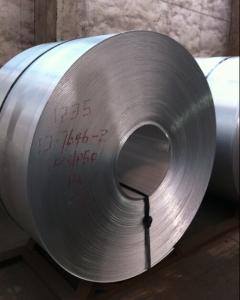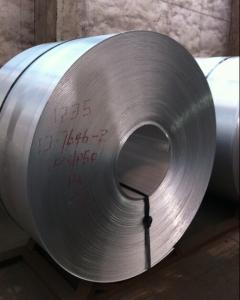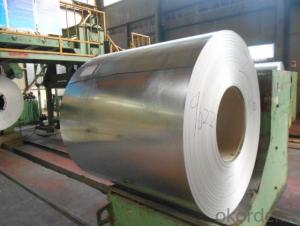Stainless Steel Cold Rolled Coil And Roll Stocks
- Loading Port:
- Shanghai
- Payment Terms:
- TT or LC
- Min Order Qty:
- 9 m.t.
- Supply Capability:
- 5000 m.t./month
OKorder Service Pledge
OKorder Financial Service
You Might Also Like
1.Structure of Product Description
Cold rolled Stainless steel sheet is widely used in the field of construction field and decoration field, etc. There are many different grades, such as: 200 series, 300 series, 400 series, 900series, etc. The detailed grade are as follows: 201, 202, 301, 304, 316, 410, 420, 430, etc.
The surface is including 2B, BA, Mirror Finish, Checkered, etc.
2. Main features of the product
a. Competitive price
b. Frist-Class Service.
c. Shortest service.
3. Image.

4. Product detailed sizes:
1000mm*2000mm, 1219mm*2438mm,1220mm*2440mm, 1250mm*2500mm,1500mm*3000mm, etc.
5. FAQ:
What is the quality standard?
---Usually our standard is GB3880-2006 or else.
What is the width range?
---It is from 1000mm to 2500mm, etc.
How many tons did you export in one year?
---Normally it is around 9000 tons totally.
Where is your client from?
---Normally it is from Japan, USA, ENGLISH, SINGAPORE, ETC.
What is your mainly products?
---Normally they are stainless steel sheet, stainless steel coil, stainless steel checkered sheet, stainless steel mirror finished sheet, color coated stainless steel sheet, etc.
- Q:How do you determine the hardness of stainless steel sheets?
- The hardness of stainless steel sheets can be determined using various methods such as the Rockwell hardness test, Brinell hardness test, or Vickers hardness test. These tests involve applying a specific amount of force or pressure to the surface of the steel sheet and measuring the depth of indentation created. The hardness value obtained from these tests indicates the resistance of the stainless steel sheet to deformation or scratching, thus providing a measure of its hardness.
- Q:What do stainless steel 304 industrial surfaces refer to?
- Acid washing: pickling is the removal of oxide and rust on the surface of iron and steel by means of acid solutions. The parts are usually immersed in aqueous solutions such as sulfuric acid to remove oxides such as oxides on the metal surface. It is the pretreatment or intermediate treatment of electroplating, enamel and rolling etc..
- Q:Can stainless steel sheets be used in chemical processing plants?
- Chemical processing plants can utilize stainless steel sheets due to their high resistance to corrosion, which makes them an ideal material for environments with chemical exposure. Stainless steel is capable of enduring exposure to a wide range of chemicals, including acids, alkalis, and solvents, without deteriorating or reacting with them. Furthermore, stainless steel sheets are easily cleaned and maintained, ensuring that they adhere to the stringent hygiene and safety standards demanded in chemical processing plants. Additionally, stainless steel possesses exceptional strength and durability, making it suitable for various applications within the facility, such as tanks, piping, pressure vessels, and heat exchangers. In conclusion, stainless steel sheets are a dependable and versatile option for implementation in chemical processing plants.
- Q:Can stainless steel sheets be used for insulation?
- Typically, stainless steel sheets do not serve as insulation materials. Despite being widely used for their durability and resistance to corrosion and heat, stainless steel lacks good insulation properties. The purpose of insulation materials is to minimize heat transfer by reducing conduction, convection, and radiation. These materials usually possess low thermal conductivity, making them effective in preventing heat transfer. On the contrary, stainless steel has high thermal conductivity, allowing it to easily conduct heat. To achieve insulation, it is more common to utilize materials like fiberglass, mineral wool, foam boards, or reflective barriers. These materials have lower thermal conductivity and can effectively trap air or create a barrier that restricts heat transfer. In comparison, stainless steel sheets cannot provide the same level of insulation as these specialized materials. Nevertheless, stainless steel sheets still find utility in construction or industrial settings due to their strength, corrosion resistance, and aesthetic appeal.
- Q:Can stainless steel sheets be used for oil and gas pipelines?
- Yes, stainless steel sheets can be used for oil and gas pipelines. Stainless steel is commonly used in the oil and gas industry due to its excellent corrosion resistance properties. It can withstand the harsh conditions of transportation and storage of oil and gas, including high-pressure, high-temperature, and corrosive environments. Stainless steel sheets are often utilized to fabricate pipeline components such as pipes, fittings, and flanges, as they offer durability, strength, and resistance to corrosion, which helps to prevent leaks and maintain the integrity of the pipeline.
- Q:Can stainless steel sheets be used for escalator steps?
- Yes, stainless steel sheets can be used for escalator steps. Stainless steel is a popular choice for escalator steps due to its durability, strength, and resistance to corrosion. It can withstand the constant foot traffic, heavy loads, and the wear and tear that escalator steps are subjected to on a daily basis. Additionally, stainless steel has a sleek and modern appearance, which adds to the overall aesthetic appeal of escalators. This makes stainless steel sheets a reliable and practical choice for escalator steps in various commercial and public settings.
- Q:Can stainless steel sheets be used for jewelry making?
- Yes, stainless steel sheets can be used for jewelry making. Stainless steel is a popular material for creating jewelry due to its durability, resistance to tarnishing, and hypoallergenic properties. It can be easily cut, shaped, and textured to create unique designs. Stainless steel sheets can be used to make various types of jewelry, including earrings, rings, bracelets, pendants, and even intricate chains. Additionally, stainless steel jewelry is often more affordable compared to precious metals like gold or silver, making it a popular choice for budget-conscious individuals or those looking for a more modern and industrial aesthetic.
- Q:What is the difference between cold rolled and hot rolled stainless steel sheets?
- The main difference between cold rolled and hot rolled stainless steel sheets lies in the manufacturing process and the resulting surface finish. Cold rolled stainless steel sheets are produced by rolling the steel at room temperature. This process involves passing the steel through a series of rollers to reduce its thickness and achieve the desired shape. Cold rolling results in a smoother and more refined surface finish, with less surface defects and a tighter tolerance on thickness. The cold rolling process also enhances the strength and hardness of the stainless steel sheet. On the other hand, hot rolled stainless steel sheets are manufactured by heating the steel above its recrystallization temperature and then rolling it through a series of rollers. This process is typically carried out at a higher temperature than cold rolling, which results in a rougher surface finish. Hot rolling is generally used for thicker sheets and produces a more variable thickness and hardness compared to cold rolling. In terms of applications, cold rolled stainless steel sheets are commonly used in industries that require precise measurements, such as automotive, aerospace, and construction. The smoother surface finish of cold rolled sheets makes them suitable for applications where aesthetics and surface quality are important. Hot rolled stainless steel sheets, on the other hand, are often used in applications where strength and durability are the primary requirements, such as structural components in buildings, industrial machinery, and equipment. In summary, the main differences between cold rolled and hot rolled stainless steel sheets are the manufacturing process, resulting surface finish, and their respective applications. Cold rolled sheets offer a smoother surface finish and tighter thickness tolerance, while hot rolled sheets have a rougher surface finish and are more suitable for applications requiring strength and durability.
- Q:Can stainless steel sheets be used for food processing?
- Yes, stainless steel sheets are commonly used in food processing due to their excellent corrosion resistance, durability, and ease of cleaning. They do not react with food, making them safe for use in various food processing applications such as food preparation surfaces, equipment, and storage containers.
- Q:What is the maximum size available for stainless steel sheets?
- The maximum size available for stainless steel sheets can vary depending on the manufacturer and supplier. However, commonly available sizes range from 4 feet by 8 feet (1220mm by 2440mm) to 5 feet by 10 feet (1524mm by 3048mm).
1. Manufacturer Overview |
|
|---|---|
| Location | |
| Year Established | |
| Annual Output Value | |
| Main Markets | |
| Company Certifications | |
2. Manufacturer Certificates |
|
|---|---|
| a) Certification Name | |
| Range | |
| Reference | |
| Validity Period | |
3. Manufacturer Capability |
|
|---|---|
| a)Trade Capacity | |
| Nearest Port | |
| Export Percentage | |
| No.of Employees in Trade Department | |
| Language Spoken: | |
| b)Factory Information | |
| Factory Size: | |
| No. of Production Lines | |
| Contract Manufacturing | |
| Product Price Range | |
Send your message to us
Stainless Steel Cold Rolled Coil And Roll Stocks
- Loading Port:
- Shanghai
- Payment Terms:
- TT or LC
- Min Order Qty:
- 9 m.t.
- Supply Capability:
- 5000 m.t./month
OKorder Service Pledge
OKorder Financial Service
Similar products
New products
Hot products
Related keywords































